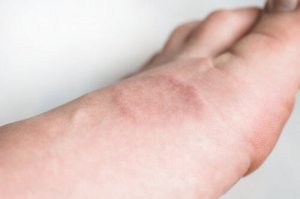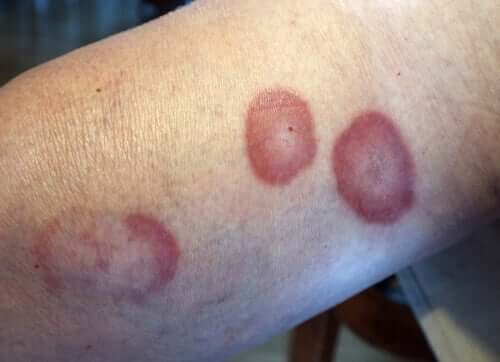What Is Granuloma Annulare?


Written and verified by the doctor Leonardo Biolatto
Granuloma annulare is an inflammatory condition that appears on the skin. Its name comes from the fact that it causes, ring-shaped or annular bumps. These are raised, red bumps that normally disappear by themselves.
The truth is that granuloma annulare is not a very common condition. It can affect anyone, but it normally appears in young people around 10 years old. Doctors aren’t sure of the cause, but, according to the data, it affects women more than men.
This condition doesn’t normally cause discomfort. However, it is very visible, which often makes it an aesthetic problem. Additionally, some people experience a lot of itchiness from the bumps.
They are still studying it, but it seems to be related to some infections, even neoplasms. In this article we’ll explain everything you need to know about granuloma annulare to be able to identify it.
What is granuloma annulare?
As we already mentioned, it’s a chronic and inflammatory skin condition. It consists of the formation of raised, red bumps, in a ring shape. Generally it appears on the hands and feet.
In truth, although we know that it affects women and young people more, we don’t know its exact cause. Even so, there are certain factors that can trigger it. For example, it can be a side effect of some medicines.
Another possible cause is a bite or sting from some insects, and it can even be a reaction to some vaccines. Granuloma annulare is also related to infections, like hepatitis. Nevertheless, it’s important to note that it isn’t a contagious disease.
Although granuloma annulare normally disappears after two years without treatment, it’s important to study it well. Scientists are trying to see whether it’s related to other systemic conditions.
It seems to be related to certain thyroid diseases and diabetes. Certain carcinogenic processes can even cause it. In these cases, there are normally more breakouts all over the body, and they don’t respond well to treatment.

You might be interested in: 7 Enemies of Healthy Skin You’ve Probably Never Heard Of
What symptoms does it cause?
Granuloma annulare, in addition to the bumps, doesn’t cause other symptoms. These lesions can be different colors, from bluish, to skin color, to red. All of them are ring-shaped and expand outward, with the center slightly sunken.
The bumps are sensitive to the touch, but don’t cause pain. However, they can cause aesthetic problems, or cause itchiness. Especially when there are many bumps all over your body.
Additionally, experts classify granuloma annulare in different groups:
- In the first group, we have localized granuloma annulare, which is the most common type. It normally appears on the hands and feet, and the lesions can be up to 5 centimeters (2 inches) across.
- There is also generalized granuloma annulare, which is the type that spreads across your whole body.
- And, finally, they classify subcutaneous granuloma. In this case, the bumps are small and hard, and they aren’t normally red.

You might like: The Differences between Atopic and Seborrheic Dermatitis
How do you treat granuloma annulare?
Granuloma annulare causes easily identifiable lesions, which means it’s normally easy to diagnose. Nevertheless, in case there’s any doubt, sometimes dermatologists request a skin biopsy to confirm it. As we noted before, the bumps normally disappear by themselves after a time.
For this reason, the condition normally lasts a maximum of two years. Therefore, you don’t necessarily have to treat it. However, it’s true that it can be annoying aesthetically, or because of the itching.
There are certain treatment options you can use if you have these issues. In some cases, you can use corticosteroid creams that help the lesions disappear faster. You might even be able to inject corticosteroids if it doesn’t respond to the creams.
In certain cases, doctors use phototherapy techniques to treat granuloma annulare. And, finally, when the lesions spread a lot and are very generalized, they can prescribe oral medications. However, the most important thing is to go to your doctor and let them decide the best treatment options.
All cited sources were thoroughly reviewed by our team to ensure their quality, reliability, currency, and validity. The bibliography of this article was considered reliable and of academic or scientific accuracy.
- Granuloma anular – Trastornos de la piel – Manual MSD versión para público general. (n.d.). Retrieved February 13, 2020, from https://www.msdmanuals.com/es-es/hogar/trastornos-de-la-piel/hipersensibilidad-y-trastornos-cutáneos-inflamatorios/granuloma-anular
- Fernandez-Anton-Martinez, M. D. C., Avilés Izquierdo, J. A., Baniandrés, O., & Suárez Fernández, R. (2012). Granuloma anular generalizado: Un reto terapéutico. Nuestra experiencia en 12 pacientes. Piel, 27(10), 543–548. https://doi.org/10.1016/j.piel.2012.07.016
- Navarro-Hernández, Cipactli Ariel, et al. “Granuloma annulare: A dermatological challenge.” Dermatología Revista Mexicana 62.3 (2018): 221-232.
This text is provided for informational purposes only and does not replace consultation with a professional. If in doubt, consult your specialist.








